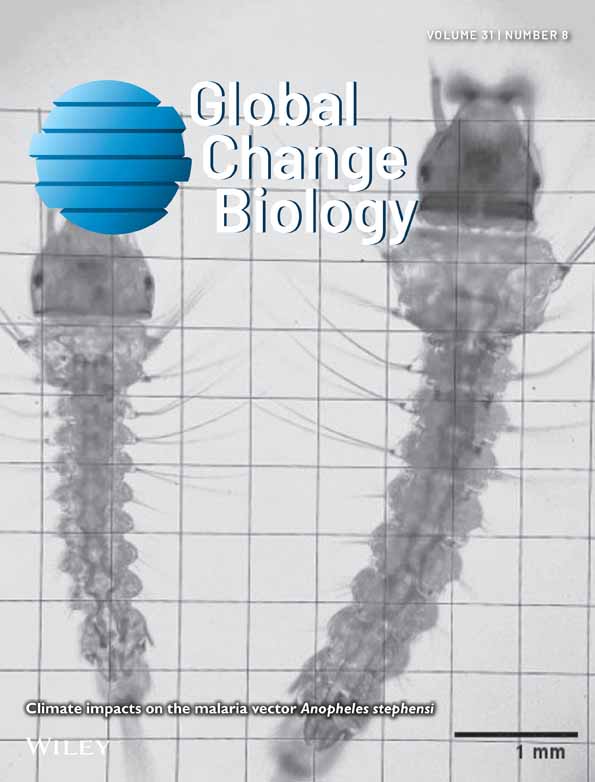Minimizing the biodiversity impact of Neotropical oil palm development
Abstract
Oil palm agriculture is rapidly expanding in the Neotropics, at the expense of a range of natural and seminatural habitats. A key question is how this expansion should be managed to reduce negative impacts on biodiversity. Focusing on the Llanos of Colombia, a mixed grassland–forest system identified as a priority zone for future oil palm development, we survey communities of ants, dung beetles, birds and herpetofauna occurring in oil palm plantations and the other principal form of agriculture in the region – improved cattle pasture – together with those of surrounding natural forests. We show that oil palm plantations have similar or higher species richness across all four taxonomic groups than improved pasture. For dung beetles, species richness in oil palm was equal to that of forest, whereas the other three taxa had highest species richness in forests. Hierarchical modelling of species occupancy probabilities indicated that oil palm plantations supported a higher proportion of species characteristic of forests than did cattle pastures. Across the bird community, occupancy probabilities within oil palm were positively influenced by increasing forest cover in a surrounding 250 m radius, whereas surrounding forest cover did not strongly influence the occurrence of other taxonomic groups in oil palm. Overall, our results suggest that the conversion of existing improved pastures to oil palm has limited negative impacts on biodiversity. As such, existing cattle pastures of the Colombian Llanos could offer a key opportunity to meet governmental targets for oil palm development without incurring significant biodiversity costs. Our results also highlight the value of preserving remnant forests within these agricultural landscapes, protecting high biodiversity and exporting avian ‘spill-over’ effects into oil palm plantations.
Introduction
Oil palm cultivation is expanding rapidly in many parts of the tropics, despite the severe environmental costs incurred when plantations replace natural habitats (Fitzherbert et al., 2008; Koh & Wilcove, 2008; Danielsen et al., 2009). Demand for oil palm is set to increase, particularly with the expanding market for biofuels (Slade et al., 2014). Although most research on environmental impacts has focussed on developments in Asia (Zhou & Thomson, 2009), oil palm expansion is gaining momentum in Africa and South America (Butler & Laurance, 2009; Sayer et al., 2012). In the Neotropics, few studies have directly assessed the impacts of oil palm expansion on biodiversity (Livingston et al., 2013), inhibiting evidence-based development policies.
The economic and social benefits of oil palm development can be high (Rist et al., 2010; Lee et al., 2011), bringing strong incentives for governments to encourage oil palm growth. The Colombian government, for example, have identified oil palm as a top priority for agricultural development, forming a mainstay of the country's ambitious biofuel programme (MADR, 2006, 2008; Castiblanco et al., 2013). An important question is how the environmental impacts of such goals can be minimized. For biodiversity, the most promising option is for policymakers to promote oil palm development on existing agricultural lands, relieving pressure on remaining wilderness areas (Koh & Wilcove, 2008; Garcia-Ulloa et al., 2012; Slade et al., 2014). There is a pressing need to identify zones where such developments can proceed with minimal environmental impacts (Laurance et al., 2014).
Many areas with climatic suitability for oil palm in the Neotropics retain extensive cover of primary forests, and therefore have major conservation value (Butler & Laurance, 2009). Other areas with climatic suitability include mixed grassland–forest systems such as the Llanos Orientales (Colombia and Venezuela) and Cerrado (Brazil), which also have unique biodiversity importance (Cardoso da Silva & Bates, 2002; Abell et al., 2008). Recent studies have identified Colombia's western Llanos as a priority area for oil palm development, in the light of both socioeconomic and environmental concerns (Garcia-Ulloa et al., 2012; Castiblanco et al., 2013). In particular, improved grasslands within this region have been proposed as key opportunities for low-impact oil palm development (Garcia-Ulloa et al., 2012). These recommendations, however, are based on coarse-scale biodiversity information derived from remote sensing, which can be highly misleading (Jetz et al., 2008; Feeley & Silman, 2011), particularly in degraded landscapes that can retain surprisingly high biodiversity value (Ranganathan et al., 2008; Edwards et al., 2011). Detailed field-based studies are therefore urgently needed to fully evaluate the biodiversity consequences of oil palm expansion in such areas.
In this study, we survey birds, herpetofauna, ants and dung beetles to evaluate the impact of oil palm development in the western Colombian Llanos. We compare the species richness and characteristics of communities occupying oil palm plantations with those of improved cattle pastures, the other principal land use in the region. We also evaluate these agricultural communities relative to the biodiversity found in remnant forests (primarily riparian strips, morichal wet forests and fragments) that are scattered across the region. We examine the extent to which remnant forests influence the communities occupying adjacent oil palm plantations and cattle pastures, allowing us to quantify the value of protecting such habitats within agricultural landscapes.
Materials and methods
Study areas
Sampling took place in three study areas in the departments of Cundinamarca and Meta, Colombia, totalling 68.6 km2 and falling within an altitudinal range of 180–320 m a.s.l. (Figure S1). The Llanos Orientales is a seminatural system dominated by grasslands interspersed with wet and dry forests. The region has a long history of human development, with widespread ‘improvement’ of grasslands for cattle grazing via the introduction of nonnative grass species, particularly in the west of the region (Etter et al., 2008). All three study areas are dominated by cattle farming on improved grasslands, together with extensive oil palm cultivation (Romero-Ruiz et al., 2010). Each study area was selected to provide a representative sample of the main habitat classes in the region, incorporating some cover of remnant forests (Figure S1). Remnant forests were predominantly composed of riparian forest strips, isolated forest fragments of varying size, and wet forests, including morichal communities dominated by the palm Mauritia flexuosa L. (Montes & San José, 1995). Pastures were managed intensively across all study areas, with floras dominated by nonnative grass species (Etter et al., 2008). All sampled oil palm plantations had at least 5 years of palm growth, with a maximum age of 28 years (Figure S2).
Biodiversity sampling
We conducted biodiversity surveys across the three main habitat types present in the study region: cattle pasture, oil palm plantations and remnant forests. We sampled each taxonomic group at points arrayed within randomly placed blocks across each habitat type. For cattle pasture and oil palm plantations, we sampled birds and herpetofauna at four points with 300 m spacing within each block, whereas for ants and dung beetles, we sampled six points with 150 m spacing. In remnant forests, the small size of some patches meant that sampling full blocks was not always feasible; sampling locations were then placed at random, ensuring that we maintained the same minimum spacing between sampling locations across all habitats (300 m for birds and herpetofauna, 150 m for ants and dung beetles). All sampling was conducted from January to May 2013, corresponding with the dry season in the region.
Ants
We placed plastic pitfall traps (depth 12 cm, radius 4 cm) at 5 m intervals along a 25 m transect centred on each sampling location (total of 159 locations across three study areas). Each trap was buried at ground level and partially filled with a liquid detergent solution, replaced daily. Traps were emptied daily over a 4 day sampling window, and all captured individuals were identified to species or morphospecies level using the reference collection at the Instituto Alexander von Humboldt (IAvH), Colombia, where all specimens were deposited. Data were recorded as daily presence or absence for each species at each sampling point (i.e. summing all five individual traps from each 25 m transect). As ants are colonial, point-level abundance cannot be meaningfully estimated from capture rates of individuals (Woodcock et al., 2011); consequently, we used incidence rather than abundance data to estimate ant species richness, and did not calculate abundance metrics for ant species.
Dung beetles (subfamily Scarabaeinae)
We placed a single pitfall trap at each point to sample dung beetles (total of 159 locations across three study areas), baiting traps with fresh human dung which attracts most dung-feeding species (Davis & Philips, 2005). Traps were collected at 24 h intervals across 4 days and were rebaited after 2 days. Species determinations were made by J. S. Cardenas, A. González and C.A. Medina-Uribe using the IAvH reference dung beetle collection, where all specimens were deposited. We used the total number of individuals of each species captured at each sampling location as an index of abundance.
Birds
An experienced surveyor (JJG) conducted four point counts of 10 min duration at each location (total of 106 locations across three study areas), avoiding conditions of rain or high winds. Routes were varied between locations each day to ensure that all points were visited both early and late in the sampling window (05:45–11:00). Unknown vocalizations were recorded using Sennheiser ME66 microphones and Olympus LS11 recording devices, allowing subsequent identification using online reference material (www.xeno-canto.org). As we were interested in modelling community responses to local habitat features surrounding each sampling point, we excluded records of birds solely observed flying overhead, whose occurrence may be independent of the specific features of each site. To control for potential cross-habitat variation in detection distances, we restricted our analyses to individuals detected within a 100 m radius of each point. Within this 100 m radius, we made no attempt to distinguish between individuals present in cropped habitat (i.e. palms or grass) and those utilizing noncrop microhabitats (including remnant forest fragments). Consequently, our bird samples represent communities utilizing the full range of microhabitats within each habitat type. We used the highest count of each species on a single sampling occasion as an index of abundance for each sampling location (Edwards et al., 2011).
Herpetofauna
Two experienced surveyors (PG & LR) conducted active searches (one nocturnal between 19:00 and 23:00, one diurnal between 09:00 and 14:00) for reptiles and amphibians along strip transects of 100 m length and 8 m width, centred on each sampling location (total of 66 locations across two study areas). Transect direction was chosen at random, and transects were walked by both observers for 35 min periods, exhaustively searching all vegetation within the transect area (excluding canopy). Species determinations were made from photographs taken in the field or specimens collected and deposited in the IAvH collection. We used the total number of individuals of each species detected at each sampling location as an index of abundance.
Statistical analysis
Species richness and diversity
We used sample-based rarefaction to compute species richness estimates for each taxonomic group in each habitat type. Using the program Estimate S (Colwell, 2000), we calculated richness estimates based on rarefaction of observed data (Sobs), as well as six estimators that account for unobserved species in each habitat (ACE, Chao1, Chao2, Jack1, Jack2 and Bootstrap), of which we took the mean as an estimate of the total species richness in each habitat (Sest). We also compared point-level species richness (taken as the total number of species detected at each point) and total abundance (the sum of all species abundances at each point) across habitats using anova tests followed by post hoc pairwise comparisons using Tukey's honestly significant difference.
Community composition and species occurrences
We assessed community-level differences across sampling locations in oil palm, improved cattle pasture and remnant forests using canonical discriminant analysis of principal components in Program CAP v3.6 (Anderson & Willis, 2003). First, we generated similarity matrices for each taxonomic group using the Bray–Curtis index (Magurran, 2004), which allows samples with more similar species assemblages to be placed closer together in reduced dimensional space. We then performed canonical discriminant analyses (CDA) of principal components from each distance matrix, evaluating the significance of community-level differences between habitats via permutation tests (n = 1000 replicates) to yield a generalized discriminant analysis (Anderson & Willis, 2003; Chao et al., 2005). We also tested the explanatory power of CDA axes for each taxonomic group via leave-one-out analysis (Anderson & Willis, 2003). To assess how oil palm communities vary in relation to stand age, we performed a second CDA in which oil palm sampling locations were grouped by palm age class (5–16, 17–21 and 22–28 years).
 (1)
(1)where ‘palm’ and ‘pasture’ are binary indicators of whether sampling points are located in either habitat, ‘cover’ is a measure of the proportionate cover of remnant forests in a 250 m radius surrounding each sampling location, and ‘edge’ is a measure of the linear distance from the sampling point to the nearest remnant forest edge (zero for all locations within forest). Both ‘cover’ and ‘distance’ were measured using Google Earth v. 7.1.2 (Landsat imagery from 2010). The intercept ai therefore represents the occurrence probability for sampling locations within remnant forests. We include habitat interaction terms for ‘cover’ and ‘distance’ to examine whether species responses differ between the two agricultural habitats. We also include random effects ‘ε’ indexed by species and site to account for residual spatial autocorrelation.
 (2)
(2)For birds, we assume that detection probabilities θi,j,k vary in relation to the timing of each visit, as most birds are easier to detect at times closer to dawn. For dung beetles, ants and herpetofauna, detection probabilities are modelled as a function of species and study area effects on the logit scale. We specify a joint bivariate normal distribution for the variance components of occurrence and detection probabilities among species (Dorazio & Royle, 2005; Kéry & Royle, 2008).
The model is hierarchical at the community level, meaning that all model parameters are random effects drawn from ‘hyper-parameter’ distributions representing variation across each taxonomic group (Kéry & Royle, 2008). To ensure that posterior parameter estimates reflect the data rather than model assumptions, we assign diffuse uniform (0,1) priors for hyper-parameter means and inverse-gamma (0.1, 10) priors for hyper-parameter variances (Dorazio et al., 2006). We fitted the model using WinBUGS version 1.4 (Spiegelhalter et al., 2003), sampling the posterior distribution of each parameter for 50 000 iterations following a burn-in of 30 000 iterations.
We used fitted models to compute mean occupancy probability estimates for each species in each habitat type in turn. For oil palm and cattle pasture, we calculated probabilities based on mean ‘cover’ and ‘distance’ levels across both sets of sampling locations combined, whereas forest estimates were based on means from forest locations alone. To account for uncertainty in parameter estimates, we generated 1000 resamples for each species/habitat contingency, sampling across the full posterior distributions of each parameter in the model.
Influence of remnant forests on species occupancy in oil palm
To explore how remnant forests influence patterns of species occupancy within agricultural habitats, we used fitted occurrence models for each species [i.e. Eqn 1 above] to predict species occupancy probabilities across 1000 dummy habitat replicates drawn from uniform distributions bounded by the observed maxima and minima for ‘cover’ and ‘distance’ variables. Following Dorazio et al. (2006), we used the resulting probabilities to generate posterior-predictive species accumulation curves for each habitat. This involved computing Bernoulli trials based on each species occurrence probability estimate derived for each dummy habitat sample, producing a sample of species accumulation curves for a given set of habitat conditions.
Results
In total across all habitats, we identified 238 ant species from a sample of 6059 morphospecies detections, 50 dung beetle species from 26 021 individuals, 243 bird species from 9992 detections and 37 herpetofauna species from 347 detections.
Biodiversity in oil palm vs. cattle pasture
For ants, dung beetles and herpetofauna, estimated total species richness was higher in oil palm than in cattle pasture (Fig. 1, 45% higher for ants, 51% higher for dung beetles and 67% higher for herpetofauna). Birds, by contrast, showed slightly higher total species richness in cattle pasture than in oil palm (Fig. 1, 23% higher). The mean overall abundance of birds was significantly higher in cattle pasture than oil palm, whereas dung beetles were considerably more abundant in oil palm than cattle pasture (Table S1). Herpetofaunal abundance did not vary significantly across habitats (Table S1).
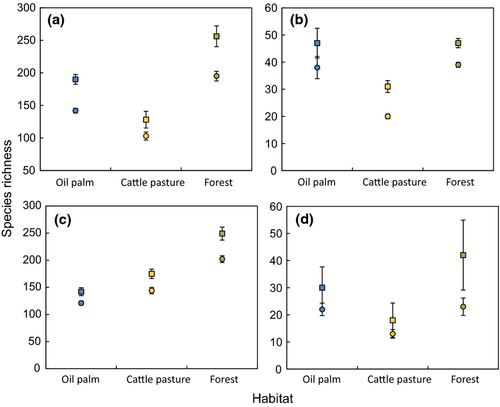
For all four taxonomic groups, there were clear differences in community composition between oil palm and cattle pasture (Fig. 2); permutation tests suggested that these differences were statistically significant (P < 0.001 for all taxa). Species occurrence probabilities in oil palm were largely uncorrelated with their respective probabilities in cattle pasture (Figure S3), indicating that most species occupied the two habitats at very different rates. Across all four taxonomic groups, the majority of species were more abundant in oil palm than cattle pasture, indicated by higher occurrence probabilities in oil palm (Figure S3). The superiority of oil palm was most marked among invertebrates, where 81% of ant species and 76% of dung beetle species had higher occupancy in oil palm than pasture (Figure S3a, b). Among vertebrates, 66% of bird species and 75% of herpetofauna had higher occurrence probabilities in oil palm than cattle pasture. Within oil palm plantations, CDA revealed significant differences in community composition between different palm age classes for ants and dung beetles (Figure S4, permutation tests P < 0.001), but not for birds or herpetofauna (Figure S4, permutation tests P > 0.05).
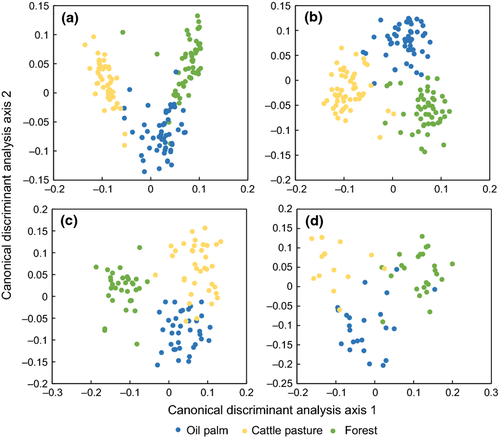
Biodiversity in agriculture vs. remnant forests
Forest communities had higher estimated total species richness than either type of agricultural habitat for ants, birds and herpetofauna, whereas dung beetle species richness was similar in remnant forests and oil palm (Fig. 1, Table S1). Sampling locations in remnant forest also had significantly higher point-level species richness among ants, birds and dung beetles relative to either agricultural habitat (Table S1). Overall abundance of dung beetles was also significantly higher in remnant forest than in the agricultural habitats (Table S1). Of species that were detected in remnant forests, 58% of ants were also detected in oil palm, compared to only 39% in cattle pasture. Similar patterns were evident for dung beetles (85% detected in oil palm, 32% in pasture), herpetofauna (62% detected in oil palm, 23% in pasture) and to a lesser extent birds (48% detected in oil palm, 43% in pasture).
Communities of all four taxonomic groups within forests were clearly differentiated from those of oil palm and cattle pasture by CAP analysis (Fig. 2); permutation tests suggested that these differences were statistically significant (P < 0.001 for all taxa). Across all four groups, the majority of species had their highest occurrence probabilities in remnant forest (73% of ants, 52% of dung beetles, 66% of birds, 54% of herpetofauna, Fig. 3). Among these ‘forest-characteristic’ species, occurrence probabilities in agriculture tended to be higher in oil palm than cattle pasture (for 88% of ants, 96% of dung beetles, 85% of birds and 75% of herpetofauna). For ants, dung beetles and herpetofauna, more species had their highest occurrence probabilities overall in oil palm (18% of ants, 26% of dung beetles, 35% herpetofauna) compared to those peaking in cattle pasture (9% of ants, 22% dung beetles and 11% of herpetofauna). By contrast, only 10% of bird species had their highest occurrence probabilities in oil palm, whereas 24% peaked in pasture (Fig. 3).
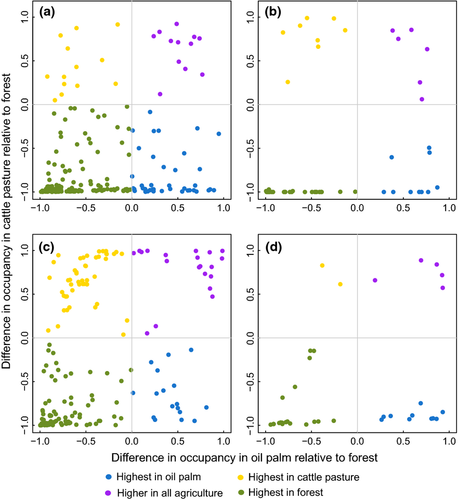
Influence of remnant forests on species occupancy in oil palm
The amount and proximity of remnant forests around sampling locations in oil palm and cattle pasture had variable effects on species occurrence probabilities (Table 1). For dung beetles and herpetofauna, community-level effects of both parameters were relatively weak and uncertain, whereas for ants and birds, hyper-parameter distributions revealed consistent effects of forest cover on species occurrence in agriculture (Table 1). Posterior-predictive samples of species area curves give a clear visual indication of these influences (Fig. 4): within oil palm, increased forest cover has a marked positive effect on bird species richness, but no clear effect on the other taxonomic groups (Fig. 4). Within cattle pasture, forest cover again has a strong positive effect on predicted bird species richness (Figure S5), but no clear effect on other taxonomic groups. None of the taxonomic groups show a clear effect of distance from forest on predicted species richness in oil palm (Fig. 4). In cattle pasture, however, distance from forest has a clear negative effect on predicted species richness of ants and birds, but not dung beetles or herpetofauna (Figure S5).
| Predictor variable | Ants | Dung beetles | Birds | Herpetofauna |
|---|---|---|---|---|
| Palm | −1.43 ± 0.29 | −1.73 ± 0.33 | −1.83 ± 0.56 | −0.79 ± 0.85 |
| Pasture | −3.24 ± 0.88 | −6.98 ± 1.53 | −2.00 ± 0.55 | −2.57 ± 1.11 |
| Cover | −0.02 ± 0.14 | −0.16 ± 0.35 | −0.43 ± 0.21 | −0.19 ± 0.41 |
| Distance | 0.35 ± 0.25 | 0.39 ± 0.21 | 0.19 ± 0.15 | 0.44 ± 0.79 |
| Palm* Cover | 0.20 ± 0.20 | 0.35 ± 0.75 | 1.87 ± 0.50 | 0.22 ± 0.81 |
| Pasture*Cover | 0.19 ± 0.13 | −0.14 ± 0.75 | 1.53 ± 0.44 | 0.13 ± 0.84 |
| Palm*Distance | −0.42 ± 0.27 | −0.60 ± 0.22 | −0.40 ± 0.13 | −0.57 ± 0.81 |
| Pasture*Distance | −0.80 ± 0.25 | −1.06 ± 0.44 | −1.23 ± 0.17 | −0.57 ± 1.04 |
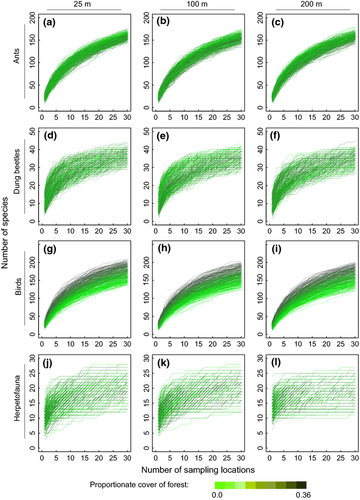
Discussion
Identifying opportunities to develop oil palm cultivation with minimal impact on biodiversity is a key priority for many tropical countries (Koh & Wilcove 2008). We show that improved grasslands currently used for cattle grazing in the Colombian Llanos could be converted to oil palm with relatively minimal biodiversity cost. Across four taxonomic groups spanning vertebrates and invertebrates, we found that oil palm plantations support communities of equal or higher biodiversity value than cattle pastures, including a wider range of species characteristic of forest habitats in the region. As significant parts of the zone of climatic suitability for oil palm are currently dominated by cattle farming (Garcia-Ulloa et al., 2012), these habitats represent a major opportunity for oil palm growth with minimal biodiversity impact. Our surveys also highlight the importance of remnant forests for biodiversity within oil palm cultivation in the Llanos, revealing positive carry-over effects for bird communities in plantations adjacent to remnant forest.
One problem with encouraging oil palm growth on existing farmland is the potential for cattle production to be displaced to other regions, potentially at the expense of natural habitats. This ‘leakage’ of environmental degradation can be an important negative side-effect of region-specific land-use policies (Ewers & Rodrigues, 2008; Fisher et al., 2011). Although cattle farming is only marginally profitable in many parts of Colombia (Gilroy et al., 2014), market demand and beef prices are unlikely to decline in the near future. Consequently, replacement of cattle pasture by oil palm could theoretically create a beef yield gap, incentivizing the conversion of natural habitats to cattle pasture in other areas. Potential solutions to this issue include policies to promote the intensification of cattle production per hectare, allowing market requirements to be met without expanding the overall footprint of agriculture (Balmford et al., 2005). Mixed farm systems, combining oil palm with cattle production in the same management unit, might also offer an effective mechanism to minimize leakage. Above all, biodiversity interests may be best served by expanding and strengthening protected area networks in regions of high conservation value, particularly in remaining natural and seminatural grasslands of the eastern Colombia Llanos.
Previous studies in regions outside the Neotropics have revealed severe declines in abundance and species richness in oil palm relative to forests (Fitzherbert et al., 2008; Edwards et al., 2010). For example, vertebrate species richness in oil palm tends to be less than half that of natural forest (Fitzherbert et al., 2008; Danielsen et al., 2009), with declines of 80% reported for birds (Koh & Wilcove, 2008; Edwards et al., 2010; but see Faruk et al., 2013 for smaller declines among anurans). Similar impacts have been documented for invertebrates, with 64% declines reported among ants (Fayle et al., 2010) and 50% declines among dung beetles (Edwards et al., 2014a,b) in Malaysian Borneo. Our surveys suggest smaller biodiversity declines in Colombian oil palm (e.g. 40% decline in bird species, 25% declines in ants and herpetofauna, no decline in dung beetles, Table S1). One explanation for this is the nature of the baseline community against which our comparisons are made. Our study region has a long history of agricultural use, and remaining forests are already heavily fragmented (Etter et al., 2008; Figure S1). Consequently, our sampled communities are likely to be depauperate relative to the preagricultural baseline (Brooks et al., 1999; Lees & Peres, 2006). Species occupying fragmented landscapes also tend to be more tolerant of habitat disturbance, and are therefore more capable of colonizing novel agricultural habitats (Swihart et al., 2003; Newbold et al., 2013), contributing to similarities between oil palm communities and those of remnant forests.
Nevertheless, our predicted totals of 190 ant species and 142 bird species in Llanos oil palm are higher than typical values reported for oil palm communities in Asia, where species are often measured in tens, not hundreds (Koh, 2008a; Edwards et al., 2010; but see Fayle et al., 2010; Lucey et al., 2014). Neotropical ecosystems tend to have higher alpha and gamma diversity than equivalents in Asia, at least for birds (Jetz et al., 2012), potentially explaining the enhanced diversity we observed. Our samples from oil palm spanned a range of stand ages (5–28 years) and consequently encompassed a broad spectrum of variation in habitat conditions, potentially contributing to diversity relative to studies from plantations of homogenous age. We found evidence for significant community variation in relation to stand age for invertebrate taxa at least, supporting this notion. There may also be differences in plantation management that favour increased species richness within our study region. It is notable that levels of remnant forest cover were relatively high throughout our sampled landscapes: oil palm points had on average 8.9% remnant forest cover within a 250 m radius (± 8.6 SD., Figure S1). Much of this habitat consisted of riparian strips buffering waterways, the protection of which is a requirement under Colombian law (Rubiano, 2011).
Previous studies have revealed positive effects of proximity to large forest tracts for within-plantation biodiversity (Koh, 2008a; Lucey & Hill, 2012), but little evidence for beneficial effects of proximity to smaller forest fragments (Edwards et al., 2010; Lucey et al., 2014). Our study system is therefore unusual in showing a clear positive effect of fragmented remnant forest cover for bird communities in oil palm. Our models indicate that increases in remnant forest cover could elevate oil palm species richness by up to 85% for birds (35% cover within 250 m, Fig. 3), though effects were limited for other taxa. Detecting positive influences of forests on oil palm biodiversity is complicated by significant cross-taxa variation in the scale at which such effects are likely to operate (Bianchi et al., 2006; Lucey et al., 2014). Nevertheless, our results demonstrate that remnant forests benefit at least one taxonomic group that is important for insect pest control in oil palm (Koh, 2008b), suggesting that fragments could provide benefits to crop production beyond soil and watershed protection (Murdiyarso et al., 2002). Studies seeking to quantify such benefits, however, have so far been equivocal (Edwards et al., 2014a,b; Gray et al., 2014). Measures to integrate forest cover within and around plantations might also have market benefits, given growing consumer preference for products with environment-friendly certification (Edwards & Laurance, 2012).
Conclusions
Maximizing the production value of existing agricultural landscapes may be a key tool in ensuring that remaining natural habitat tracts are spared from agricultural development (Fischer et al., 2008; Edwards et al., 2010). In eastern parts of the Colombian Llanos, large areas of natural and seminatural grassland, wetland and forest remain isolated from population centres and transport conduits, retaining significant global biodiversity value (Etter et al., 2008; Garcia-Ulloa et al., 2012). These areas are at risk from future oil palm development, facilitated by expanding road networks and improved water management techniques (Garcia-Ulloa et al., 2012). Such developments could have severe negative consequences for biodiversity. We argue that development policies should promote the siting of new plantations within existing improved agricultural landscapes ahead of these natural and seminatural habitats. We also argue that remnant forests should be protected within agricultural landscapes, given their important role in providing refugia for biodiversity within highly degraded environments (Koh et al., 2009). In Colombia, policies to promote oil palm development within improved Llanos grazing pastures appear to offer the best means of achieving development goals with sustainability, alleviating the risk of devastating biodiversity losses.
Acknowledgements
We thank Apolinar Rojas, ASOHUMEA, for invaluable support during fieldwork, and Juan Carlos Espinosa, Fedepalma, and Ricardo Root Grubiano, Cenipalma, for helpful discussions. We thank plantation managers at Palumea Ltda, Copalma Ltda and Guajcaramo S.A. for allowing access to their land. We thank staff at the Instituto de Investigación de Recursos Biológicos Alexander von Humboldt, particularly Fernando Forero, for logistical support. Funding was provided to T. Haugaasen and D. Edwards by the Research Council of Norway, grant number 208836. This is publication #4 of the Biodiversity, Agriculture and Conservation in Colombia/Biodiversidad, Agricultura, y Conservación en Colombia (BACC) project.



